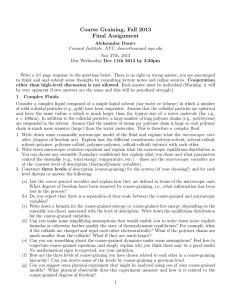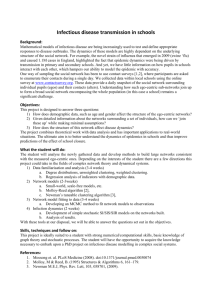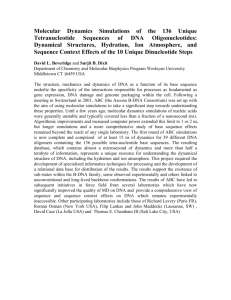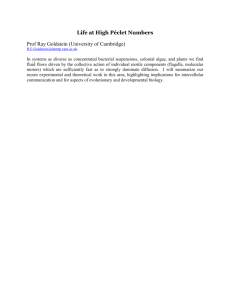doc format - Department of Applied Mathematics
advertisement
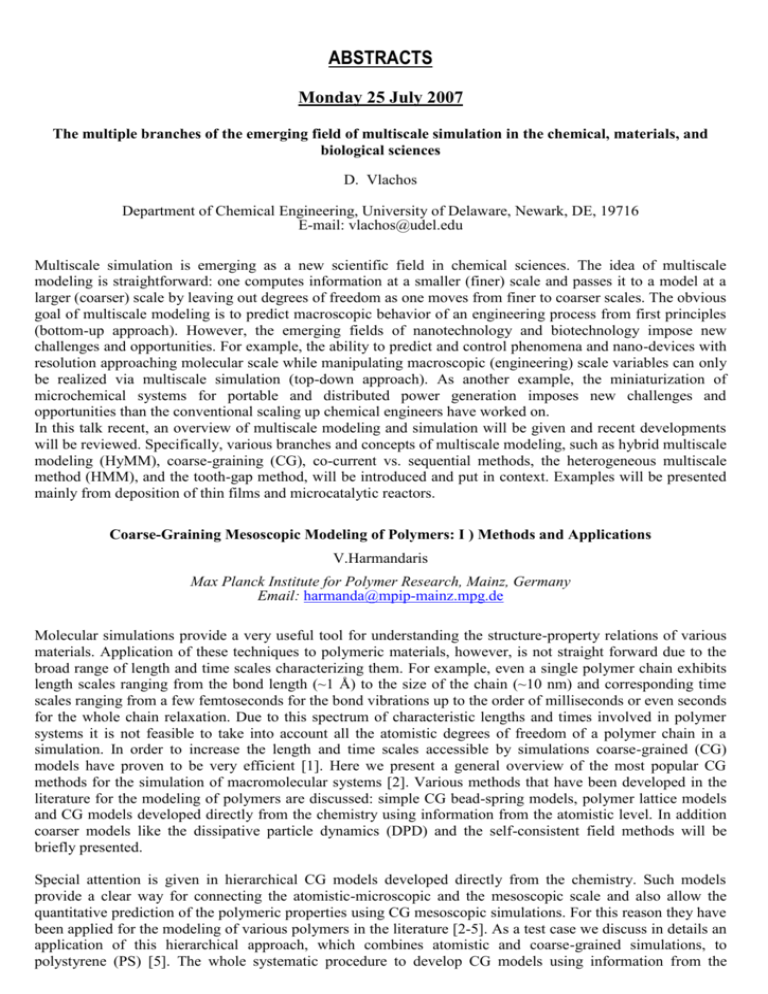
ABSTRACTS Monday 25 July 2007 The multiple branches of the emerging field of multiscale simulation in the chemical, materials, and biological sciences D. Vlachos Department of Chemical Engineering, University of Delaware, Newark, DE, 19716 E-mail: vlachos@udel.edu Multiscale simulation is emerging as a new scientific field in chemical sciences. The idea of multiscale modeling is straightforward: one computes information at a smaller (finer) scale and passes it to a model at a larger (coarser) scale by leaving out degrees of freedom as one moves from finer to coarser scales. The obvious goal of multiscale modeling is to predict macroscopic behavior of an engineering process from first principles (bottom-up approach). However, the emerging fields of nanotechnology and biotechnology impose new challenges and opportunities. For example, the ability to predict and control phenomena and nano-devices with resolution approaching molecular scale while manipulating macroscopic (engineering) scale variables can only be realized via multiscale simulation (top-down approach). As another example, the miniaturization of microchemical systems for portable and distributed power generation imposes new challenges and opportunities than the conventional scaling up chemical engineers have worked on. In this talk recent, an overview of multiscale modeling and simulation will be given and recent developments will be reviewed. Specifically, various branches and concepts of multiscale modeling, such as hybrid multiscale modeling (HyMM), coarse-graining (CG), co-current vs. sequential methods, the heterogeneous multiscale method (HMM), and the tooth-gap method, will be introduced and put in context. Examples will be presented mainly from deposition of thin films and microcatalytic reactors. Coarse-Graining Mesoscopic Modeling of Polymers: I ) Methods and Applications V.Harmandaris Max Planck Institute for Polymer Research, Mainz, Germany Email: harmanda@mpip-mainz.mpg.de Molecular simulations provide a very useful tool for understanding the structure-property relations of various materials. Application of these techniques to polymeric materials, however, is not straight forward due to the broad range of length and time scales characterizing them. For example, even a single polymer chain exhibits length scales ranging from the bond length (~1 Å) to the size of the chain (~10 nm) and corresponding time scales ranging from a few femtoseconds for the bond vibrations up to the order of milliseconds or even seconds for the whole chain relaxation. Due to this spectrum of characteristic lengths and times involved in polymer systems it is not feasible to take into account all the atomistic degrees of freedom of a polymer chain in a simulation. In order to increase the length and time scales accessible by simulations coarse-grained (CG) models have proven to be very efficient [1]. Here we present a general overview of the most popular CG methods for the simulation of macromolecular systems [2]. Various methods that have been developed in the literature for the modeling of polymers are discussed: simple CG bead-spring models, polymer lattice models and CG models developed directly from the chemistry using information from the atomistic level. In addition coarser models like the dissipative particle dynamics (DPD) and the self-consistent field methods will be briefly presented. Special attention is given in hierarchical CG models developed directly from the chemistry. Such models provide a clear way for connecting the atomistic-microscopic and the mesoscopic scale and also allow the quantitative prediction of the polymeric properties using CG mesoscopic simulations. For this reason they have been applied for the modeling of various polymers in the literature [2-5]. As a test case we discuss in details an application of this hierarchical approach, which combines atomistic and coarse-grained simulations, to polystyrene (PS) [5]. The whole systematic procedure to develop CG models using information from the atomistic level is presented. The capability of the CG simulations to predict the polymer structure and the polymer dimensions is examined by comparing the results with data obtained from atomistic simulations and experiments. In addition we examine the effect of the mapping by comparing two different mapping schemes [6]. Finally a systematic way to back-mapping the CG configurations onto the atomistic level is presented [5]. This opens new routes for obtaining well equilibrated high molecular weight polymeric systems and also providing very long dynamic trajectories at the atomistic level for these polymers. REFERENCES 1. K. Kremer, in Proceedings of the International School of Solid State Physics - 34th Course: Computer Simulations in Condensed Matter: from Materials to Chemical Biology ed. by Binder, K.; Ciccoti, G., Erice, 2006. 2. “Simulation Methods for Polymers”, ed. by D.N. Theodorou and M. Kotelyanski, Marcel Dekker, 2004. 3. W. Tschöp, K. Kremer, J. Batoulis, T. Buerger, O. Hahn, Acta Polym. 49, 61 (1998). 4. D. Reith, H. Meyer, F. Müller-Plathe Macromolecules 34, 2335 (2001). 5. V.A. Harmandaris, N. Adhikari, N. van der Vegt, K. Kremer, Macromolecules 39, 67083 (2006). 6. V.A. Harmandaris, D. Reith, N. van der Vegt, K. Kremer, submitted to Macrom. Chem. and Phys. Stochastic dynamics in atomistic and continuum models A. Szepessy Royal Institute of Technology, Sweeden E-mail: szepessy@kth.se Stochastic Langevin dynamics is used for simulating molecular dynamics at constant temperature. More than thirty years ago, Robert Zwanzig showed that a Hamiltonian system of harmonic heat bath interactions with particles, for stochastic initial data, can be modeled by a Langevin equation. It is also well known that Langevin dynamics can be approximated by simpler Smoluchowski dynamics (Brownian dynamics) on long diffusion time scales as the molecular friction increase. I will present some simple ideas and error estimates for coarse-graining: - heat bath to Langevin, - Langevin to Smoluchowski, and - Smoluchowski to continuum stochastic PDE for phase change dynamics. Fluctuations of the equilibrium profile of a condensating zero range process M. Loulakis University of Crete E-mail: loulakis@tem.uoc.gr For certain choices of the jump rate function the equilibrium measures of a zero range process exhibit a phasetransition in density. There is a critical particle density below which the particle density has a uniform macroscopic profile, but above which particles form a bulk at the critical density and the remaining ones condensate on a single randomly chosen site. We study the hydrodynamic limit of the fluctuations around this profile and prove that they converge to the bridge of a Levy process (joint work with Ines Armendariz.) Tuesday 26 July 2007 Temporal acceleration of stochastic simulation D. G. Vlachos Department of Chemical Engineering and Center for Catalytic Science and Technology, University of Delaware, Newark, DE, 19716 E-mail: vlachos@udel.edu Kinetic Monte Carlo (KMC) simulations have emerged in the past few decades as one of the preeminent computational tools for science and engineering research, in diverse problems ranging from materials growth, to catalysis, to DNA/surface interactions, to image processing, and to modeling of metabolic pathways for biochemical engineering and bio-informatics. Despite their widespread use, KMC simulations are limited to short length and time scales, while device sizes and morphological features in experiments often involve much larger spatial and temporal scales. In this talk various stochastic methods will be discussed. These methods will range from the exact stochastic simulation method for spatially homogeneous systems, to various approximate accelerated stochastic methods, to the chemical Langevin equation. The connections between the various methods will be highlighted. Finally, the need for stochastic simulation will be illustrated with examples from systems biology, nanoscopic systems, and interacting systems found in catalysis and crystal growth. Coarse-Graining Mesoscopic Modeling of Polymers: II ) Dynamics and Biological Applications V.Harmandaris Max Planck Institute for Polymer Research, Mainz, Germany Email: harmanda@mpip-mainz.mpg.de Coarse grained (CG) simulations can be used for studying both the static and dynamic properties of polymeric systems. Here we give a detailed overview of the capability of CG methods to predict the dynamics of polymers. In the literature usually CG models have been used for the qualitative study of the polymer dynamics and the prediction of the universal behavior (“power laws”) [1]. Only recently, through the systematic development of CG models using information from the atomistic level, it has been allowed to investigate quantitatively the dynamical behavior of polymeric systems [2-3]. Some typical examples of the polymer dynamics predicted by the CG models is given. In addition the possibility of studying the dynamics of polymer in a broad range of temperatures is presented [4]. Next a short overview of the application of the CG models to the modeling of biopolymers is given. As an example the study of biological membranes through CG mesoscopic simulations is presented. These simulations have the advantage of being able to relate the membrane properties with structure and composition at the molecular level [5]. First a simple and very efficient solvent-free CG model for the modeling of lipid (amphiphilic) molecules is shown [6]. Then we discuss two examples of the use of such a CG model for studying the properties of the biological membranes at the molecular level. The first is related with the curvature elasticity of membranes. A novel methodology for studying the curvature elasticity of membranes using CG mesoscopic simulations is presented. The basic idea is to impose a deformation of the membrane and measure the force required to hold it in the deformed state [7]. Specifically we stretch a cylindrical vesicle and measure the force needed for such an extension. We show that by measuring the force acting on the stretching cylindrical vesicle the bending modulus, κ, can be calculated in a much faster and more efficient way than from the analysis of the spectrum of equilibrium membrane fluctuations [8]. The second example considers the interaction between proteins and biological membranes. Very large length-time scale CG simulations reveal for the first time that curvature-induced model proteins adsorbed on lipid bilayer membranes can experience attractive interactions that arise purely as a result of a membrane curvature [9]. Owing to its universal nature curvature-mediated interactions can operate even between proteins without any specific interactions. Finally we discuss the (many) open questions in the study of polymers and/or biopolymers through CG models: how do many-body terms are incorporated in the CG description? Is it possible to estimate in advance the error due to the loss of some degrees of freedom, when we go from the microscopic to the mesoscopic description? Are the density dependent CG force fields thermodynamically consistent? How the noise and/or the fluctuations are described through the CG potentials? Why the CG dynamics is faster than the real one? Can we obtain a mathematical consistent mesoscopic simulation tool for the quantitative predictions of both structural and dynamical properties of polymers and biopolymers? REFERENCES 1. “Monte Carlo and Molecular Dynamics Simulations in Polymer Science”, ed. by K. Binder, Oxford University Press: New York, 1995. 2. S. Leon, L. Delle Site, N.F.A. van der Vegt, K. Kremer, Macromolecules 38, 8078 (2005). 3. V.A. Harmandaris, N. Adhikari, N. van der Vegt, K. Kremer, Macromolecules 39, 67083 (2006). 4. V.A. Harmandaris, N. Adhikari, N. van der Vegt, K. Kremer, B. Mann, R. Voelkel, H. Weiss, CC. Liew, to be published in Macromolecules. 5. “Structure and Dynamics of Membranes”, R. Lipowsky and E. Sackmann (Eds.), Elsevier, Amsterdam, 1995. 6. I.R. Cooke, K. Kremer and M. Deserno, Phys. Rev. E 72, 011506 (2005). 7. V. Harmandaris and M. Deserno, J. Chem. Phys. 125, 204905 (2006). 8. U. Seifert, Adv. Phys. 46, 13 (1997). 9. B. Reynolds, G. Illya, V. Harmandaris, M.M. Muller, K. Kremer and M. Deserno, Nature 447, 461 (2007). Reconstruction strategies for coarse-grained stochastic lattice systems J.Trashorras University Paris-Dauphine E-mail: xose@ceremade.dauphine.fr We present several ways to get samples from a Gibbs measure conditionned on coarse-grained configurations. Adaptive error estimation and approximation for ordinary differential equations. G. Zouraris University of Crete E-mail: zouraris@tem.uoc.gr We plan to introduce here the basic ideas for global error estimation and its control. A variational principle, inspired by optimal control, yields a simple derivation of an error representation, global error = \sum local error · weight, for general approximation of functions of solutions to ordinary differential equations. This error representation is then approximated by a sum of computable error indicators, to obtain a useful global error indicator for adaptive mesh refinements. We will describe a simple and general adaptive algorithm with proven convergence rates. Numerical examples will illustrate the behavior of the adaptive algorithm. Wednesday 27 July 2007 Methods for spatial acceleration of stochastic simulation D. G. Vlachos Department of Chemical Engineering and Center for Catalytic Science and Technology, University of Delaware, Newark, DE, 19716 E-mail: vlachos@udel.edu In this talk, I will present mainly collaborative work with Prof. Katsoulakis plus some additional concepts on spatial coarse-graining of lattice, kinetic Monte Carlo (KMC) simulation. Concepts of hierarchical multiscale modeling (bottom-up and top-down approaches), spatial adaptivity, error estimates via information theory, stochastic closures, and multigriding will be introduced. Examples will be presented from biotechnology and scale-up of nanotechnological processes. For example, I will discuss how one could use such a multiscale framework to carry out control of self-assembly processes in heteroepitaxy and compare to experimental data on Pb/Cu(111) system. Coarse-graining and microscopic reconstruction in simulations of stochastic particle systems P. Plechac Department of Mathematics, University of Tennessee and Oak Ridge National Laboratory E-mail: plechacp@ornl.gov Coarse-graining broadly refers to reduction of degrees of freedom or scales in large systems of interacting particles. The CG procedure has been used in many areas of computational physics and chemistry to reduce computational time and to extend length and time scales to be simulated in systems that exhibit multi-scale behavior. We discuss mathematical and numerical issues that allow for a more systematic development of coarse-graining algorithms. We focus on approximating (compressing) the coarse-grained measure rather than working directly with coarse-grained interaction potentials. We present mathematical tools that yield error quantification of such approximations. We shall briefly describe how the methods of statistical mechanics (e.g., cluster expansions) lead to improved schemes with compressed long-range interaction kernels.We discuss how the developed methodology can be applied to systematic computation of coarse-grained models used in simulations of polymeric systems.On specific examples of lattice as well as off-lattice dynamics (simulations of spin systems or polymers) we demonstrate that computational implementation of constructed coarse-grained approximation leads to significant CPU speed up of simulations. (presented results are from the joint work with Markos Katsoulakis, Luc rey-Bellet, UMASS, Amherst, Dimitrios Tsagkarogiannis, Max-Planck Institute for Mathematics in the Sciences). Adaptive weak approximation of diffusions with jumps R. Tempone Florida State University E-mail: rtempone@scs.fsu.edu We develop Euler-Maruyama adaptive time stepping simulation schemes for the approximation of a functional of a diffusion with jumps that achieve a prescribed precision. The main results are the derivation of new expansions for the time discretization error, with computable leading order term in a posteriori form. These expansions are based on stochastic flows and discrete dual backward algorithms, and with the estimation of the statistical error,lead to efficient and accurate computation of global error estimates, extending our previous results for Ito diffusions. Adaptive algorithms for either deterministic or trajectory dependent time stepping are proposed. Numerical examples show the performance of the proposed error approximations and of the described adaptive schemes. Higher order methods for the coarse-graining of stochastic lattice systems D. Tsagkarogiannis Max Planck Institute, Leipzing E-mail: tsagkaro@mis.mpg.de In this talk we present a method for designing higher order numerical schemes for stochastic lattice systems at a coarse-grained level. The main tool is the standard cluster expansion of the partition function of the constrained (by the coarse-graining condition) system in order to determine the effective Hamiltonians at the coarse level. We will discuss systems with both short and long range interactions.
